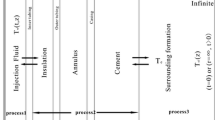Abstract
Compressed Air Energy Storage (CAES) is a commercial, utility-scale technology that is suitable for providing long-duration energy storage. Underground air storage caverns are an important part of CAES. In this paper, an analytical solution for calculating air leakage and energy loss within underground caverns were proposed. Using the proposed solution, the air leakage and energy loss under a typical CAES operation pressure were analyzed, and the influences of the permeability of the concrete lining and the lining thickness on the sealing efficiency of underground caverns were investigated. The results showed that under a typical CAES operation pressure, a concrete lining with a permeability of less than 6.36 × 10−18 m2 would result in an acceptable air leakage rate of less than 1%. Air leakage will increase linearly with increasing lining permeability. Increasing the thickness of the concrete lining could enhance the sealing efficiency of the storage cavern.
Similar content being viewed by others
References
Allen, R. D., Doherty, T. J., and Fossum, A. F. (1982). Geotechnical issues and guidelines for storage of compressed air in excavated hard rock caverns, Report No. PNL-4180, Pacific Northwest Laboratory, Richland, WA, USA.
Budt, M., Wolf, D., Span, R., and Yan, J. (2016). “A review on compressed air energy storage: Basic principles, past milestones and recent developments.” Applied Energy, Vol. 170, pp. 250–268, DOI: https://doi.org/10.1016/j.apenergy.2016.02.108.
Chen, H., Cong, T. N., Yang, W., Tan, C., Li, Y., and Ding, Y. (2009). “Progress in electrical energy storage system: A critical review.” Progress in Natural Science, Vol. 19, No. 3, pp. 291–312, DOI: https://doi.org/10.1016/j.pnsc.2008.07.014.
Crotogino, F., Mohmeyer, K. U., and Scharf, R. (2001). Huntorf CAES: More than 20 years of successful operation, Solution Mining Research Institute, Orlando, FL, USA.
Dopita, M. and Williamson, R. (2010). Clean energy Australia 2010, Clean Energy Council, Australian Academy of Sciences.
Giramonti, A. J., Lessard, R. D., Blecher, W. A., and Smith, E. B. (1978). “Conceptual design of compressed air energy storage electric power systems.” Applied Energy, Vol. 4, No. 4, pp. 231–249, DOI: https://doi.org/10.1016/0306-2619(78)90023-5.
Glamheden, R. and Curtis, P. (2006). “Excavation of a cavern for highpressure storage of natural gas.” Tunnelling and Underground Space Technology, Vol. 21, No. 1, pp. 56–67, DOI: https://doi.org/10.1016/j.tust.2005.06.002.
Gong, L. S. (1995). Concrete practical manual, China Building Industry Press, Beijing, China.
Guo, C., Pan, L., Zhang, K., Oldenburg, C. M., Li, C., and Li, Y. (2016). “Comparison of compressed air energy storage process in aquifers and caverns based on the huntorf caes plant.” Applied Energy, Vol. 181, pp. 342–356, DOI: https://doi.org/10.1016/j.apenergy.2016.08.105.
Guo, C., Zhang, K., Li, C., and Wang, X. (2016). “Modelling studies for influence factors of gas bubble in compressed air energy storage in aquifers.” Energy, Vol. 107, pp. 48–59, DOI: https://doi.org/10.1016/j.energy.2016.04.003.
Hadjipaschalis, I., Poullikkas, A., and Efthimiou, V. (2009). “Overview of current and future energy storage technologies for electric power applications.” Renewable and Sustainable Energy Reviews, Vol. 13, No. 6, pp. 1513–1522, DOI: https://doi.org/10.1016/j.rser.2008.09.028.
Kim, H. M., Rutqvist, J., Ryu, D. W., Choi, B. H., Sunwoo, C., and Song, W. K. (2012). “Exploring the concept of Compressed Air Energy Storage (CAES) in lined rock caverns at shallow depth: A modeling study of air tightness and energy balance.” Applied Energy, Vol. 92, pp. 653–667, DOI: https://doi.org/10.1016/j.apenergy.2011.07.013.
Kushnir, R., Dayan, A., and Ullmann, A. (2012). “Temperature and pressure variations within compressed air energy storage caverns.” International Journal of Heat & Mass Transfer, Vol. 55, Nos. 21–22, pp. 5616–5630, DOI: https://doi.org/10.1016/j.ijheatmasstransfer.2012.05.055.
Oldenburg, C. M. and Pan, L. H. (2013). “Porous media compressed-air energy storage (pm-caes): Theory and simulation of the coupled wellbore–reservoir system.” Transport in Porous Media, Vol. 97, No. 2, pp. 201–221, DOI: https://doi.org/10.1007/s11242-012-0118-6.
Rutqvist, J., Kim, H. M., Ryu, D. W., Synn, J. H., and Song, W. K. (2012). “Modeling of coupled thermodynamic and geomechanical performance of underground compressed air energy storage in lined rock caverns.” International Journal of Rock Mechanics and Mining Sciences, Vol. 52, pp. 71–81, DOI: https://doi.org/10.1016/j.ijrmms.2012.02.010.
Succar, S. and Williams, R. H. (2008). Compressed air energy storage: Theory, resources, and applications for wind power, Report 8, Princeton Environmental Institute, Princeton, NJ, USA.
Xia, C., Zhou, Y., Zhou, S., Zhang, P., and Wang, F. (2015). “A simplified and unified analytical solution for temperature and pressure variations in compressed air energy storage caverns.” Renewable Energy, Vol. 74, pp. 718–726, DOI: https://doi.org/10.1016/j.renene.2014.08.058.
Yokoyama, H., Shinohara, S., and Kato, Y. (2002). Demonstrative operation of pilot plant for compressed air energy storage power generation, Jpn. Electr. Power Civ. Eng. Assoc., Japan (in Japanese).
Zhou, Y. (2017). Air tightness and durability of internal seals in lined rock caverns for compressed air energy storage, PhD Thesis, Tongji University, Shanghai, China.
Zhou, S. W., Xia, C. C., Du, S. G., Zhang, P. Y., and Zhou, Y. (2015). “An analytical solution for mechanical responses induced by temperature and air pressure in a lined rock cavern for underground compressed air energy storage.” Rock Mechanics and Rock Engineering, Vol. 48, No. 2, pp. 749–770, DOI: https://doi.org/10.1007/s00603-014-0570-4.
Zhuang, X., Huang, R., Liang, C., and Rabczuk, T. (2014). “A coupled thermo-hydro-mechanical model of jointed hard rock for compressed air energy storage.” Mathematical Problems in Engineering, Vol. 2014, Article ID 179169, p. 11, DOI: https://doi.org/10.1155/2014/179169.
Author information
Authors and Affiliations
Corresponding author
Rights and permissions
About this article
Cite this article
Ye, B., Cheng, Z., Ye, W. et al. An Analytical Solution for Analyzing the Sealing-efficiency of Compressed Air Energy Storage Caverns. KSCE J Civ Eng 23, 2025–2035 (2019). https://doi.org/10.1007/s12205-019-0260-6
Received:
Revised:
Accepted:
Published:
Issue Date:
DOI: https://doi.org/10.1007/s12205-019-0260-6




